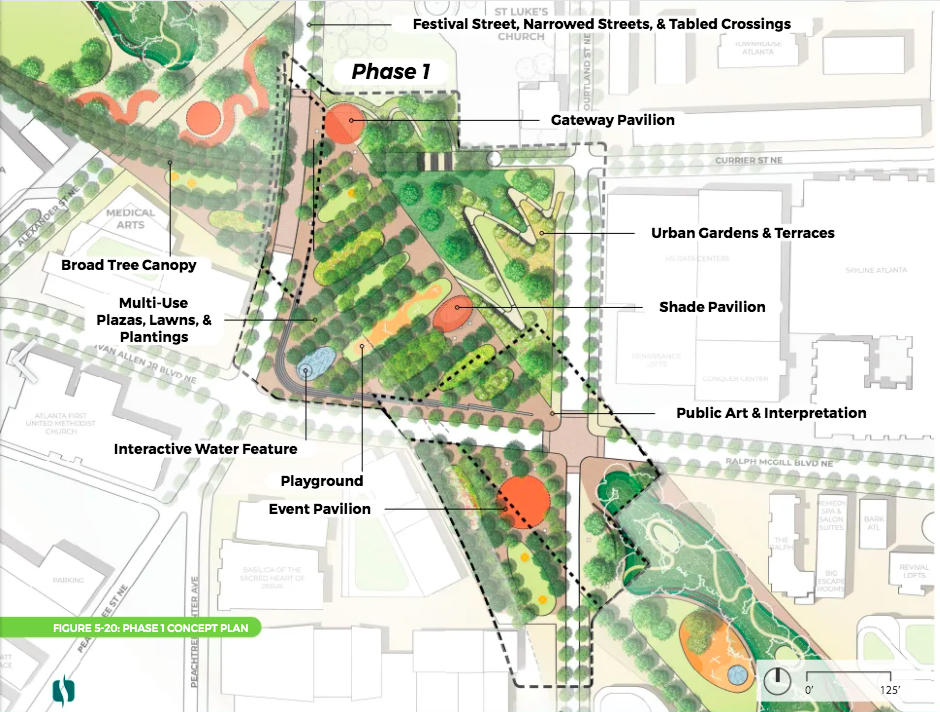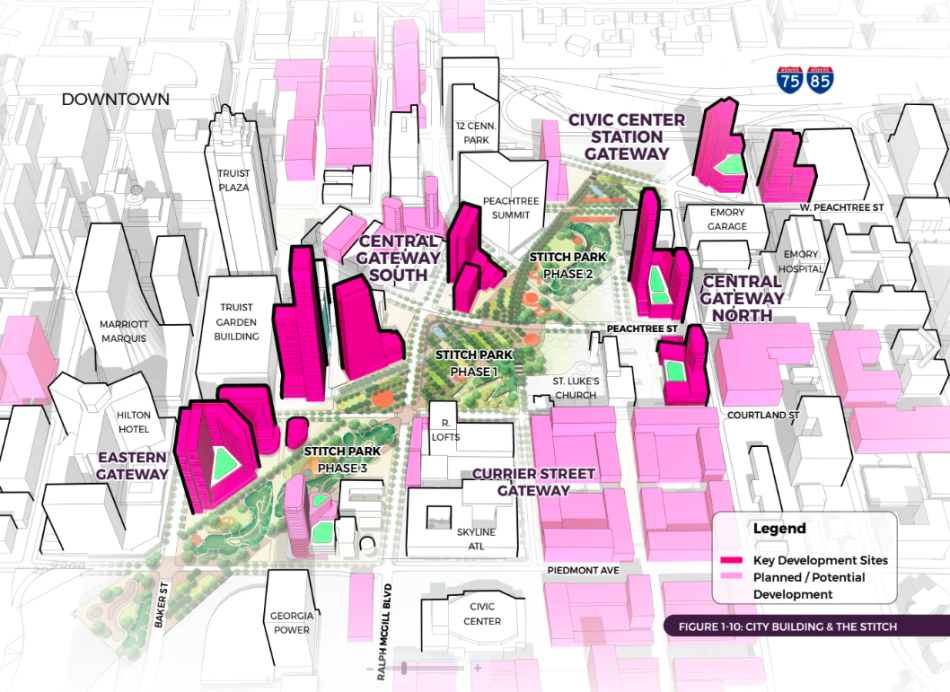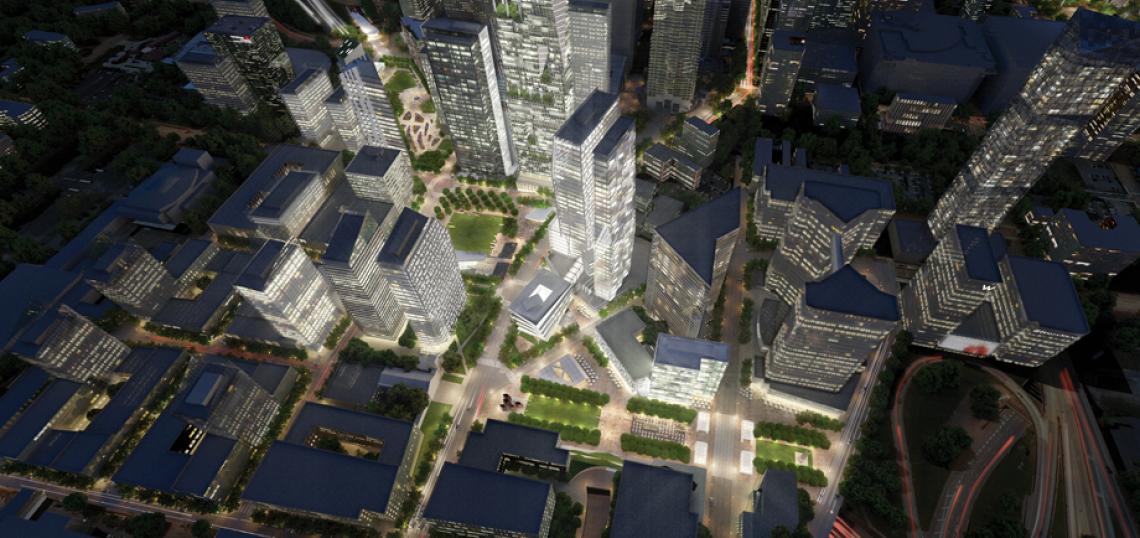A tax bill recently proposed in Washington D.C. could permanently defund a transformative greenspace and infrastructure project in downtown Atlanta that’s finally nearing construction.
According to representatives with U.S. Sen. Raphael Warnock’s office, Atlanta’s highway-capping the Stitch stands to lose a crucial $157.5 million in funding for its initial phase as part of $3.8 trillion in spending and cuts dubbed by President Donald Trump’s administration the “Big Beautiful Bill.”
Funding earmarked for the Stitch in spring 2024 that appeared to green-light the project’s first phase of construction would instead join roughly $4 billion rescinded from infrastructure projects across the country as part of Trump’s tax and spending bill.
The Stitch would lose its funding if the Senate passes House legislation as it currently stands, “effectively gutting the [Atlanta] project before it can even begin,” as John Parker III, Warnock’s deputy communications director, wrote in an email to Urbanize Atlanta.
The Stitch was initially proposed back in 2016 but had been gathering momentum over the past year like never before, with plans to break ground on the first phase in 2026.
 Components of phase 1, as currently planned. Project leaders' schedule calls for breaking ground on this section in 2026. Courtesy of Atlanta Downtown Improvement District
Components of phase 1, as currently planned. Project leaders' schedule calls for breaking ground on this section in 2026. Courtesy of Atlanta Downtown Improvement District
Stitch’s initial phase (now envisioned as 5.7 acres) appeared to have secure about $200 million needed to build it, mostly from a federal Reconnecting Communities and Neighborhoods grant approved by the previous administration. It calls for capping the highway between Peachtree and Courtland streets and upgrading connections to existing street corridors, helping to stitch Midtown and downtown back together across the Connector’s gouge.
Warnock’s office says killing the Stitch would have broader economic implications across Georgia’s economy.
“The Stitch is an economic development catalyst, much like the Beltline, that will create thousands of permanent and construction jobs and a rare opportunity for new residential and retail development in the heart of Atlanta,” Parker wrote.
 Planned connectivity for the Stitch's first phase. Courtesy of Atlanta Downtown Improvement District
Planned connectivity for the Stitch's first phase. Courtesy of Atlanta Downtown Improvement District
“What’s more, the Stitch will create new mobility options across I-75/85, reducing commutes and connecting Atlantans to popular destinations on both sides of the highway,” Park continued. “This transformational investment in our city’s infrastructure would help Atlanta continue to be one of the premier destinations in the world for global events for decades to come. Unfortunately, partisan fighting has led to this project becoming a political issue, instead of the economic revitalization opportunity that it is.”
Warnock’s office noted the Atlanta City Council approved in April a new tax system to fund the Stitch project—plans the federal rollback could disrupt. [UPDATE: 4:33 p.m., June 3: The Stitch's communications team reaches out with the following, regarding potential alternate funding sources: "The Stitch Special Services District is not expressly contingent on the federal grant. A change in status of the grant would necessitate a conversation with the City of Atlanta about how to proceed with the use of the SSD proceeds, but the Special Services District has been created, and properties will be assessed the millage rate on 2024 tax bills independent of the grant status."]
“At a time when many Georgians are struggling to make ends meet—and good jobs are hard to come by—taking away jobs from people looking for work is not the answer,” wrote Parker.
Project spearheads Central Atlanta Progress and Atlanta Downtown Improvement District released a master plan for the Stitch project in December, following 18 months of public meetings and input from more than 6,000 stakeholders. It lays out a roadmap for three phases of the Stitch, including land-use policies, key development sites (to include affordable housing), and both short and long-term transportation upgrades.
The first phase is envisioned as the green heart of the project, with pathways, native gardens, a plaza, shade structures, pavilions, a playground, restrooms, and other features where the gash in downtown’s urban landscape exists today.
Phases two and three, tentatively scheduled to begin construction in 2029 and 2033, respectively, would require a variety of additional funding sources. Those could include state and federal grants, commitments from the City of Atlanta, philanthropy, and “real estate value capture,” project leaders have said.
 Overview of the three-phase Stitch proposal and potential related development sites. The area has the capacity to handle 16,000 new housing units at a variety of income levels, project leaders have said. Courtesy of Atlanta Downtown Improvement District
Overview of the three-phase Stitch proposal and potential related development sites. The area has the capacity to handle 16,000 new housing units at a variety of income levels, project leaders have said. Courtesy of Atlanta Downtown Improvement District
The most recent Stitch projections called for 14 acres of new public space eventually being created over the downtown Connector—finishing in roughly 11 years, or sometime in 2036, pending funding.
Another highway-capping proposal, the Connector Park concept in Midtown, officially bowed out of the running for local, federal, and philanthropic funding in July. Meanwhile, design and fundraising work for Buckhead’s highway-topping HUB404 project is ongoing.
...
Follow us on social media:
Twitter / Facebook/and now: Instagram
• Downtown news, discussion (Urbanize Atlanta)






